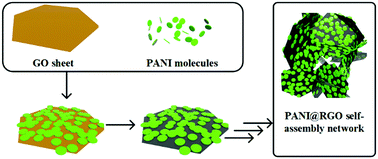A self-assembly route to porous polyaniline/reduced graphene oxide composite materials with molecular-level uniformity for high-performance supercapacitors†
Abstract
Polyaniline/graphene composites constitute an important class of electrode materials for supercapacitors. In this paper, we designed a new self-assembly method for preparing polyaniline/reduced graphene oxide three-dimensional porous composite gels with molecular-level uniformity even at a very high PANI content (>80%). The method involves two successive self-assembly processes, namely, two-dimensional assembly of polyaniline on graphene oxide sheets in a water/N-methyl-2-pyrrolidone blend solvent, and three-dimensional reduction-assembly of the obtained polyaniline/graphene oxide composite sheets. The prepared polyaniline/reduced graphene oxide composite gels possess a three-dimensional porous network composed of reduced graphene oxide sheets, which are covered by polyaniline molecules with controlled content. Because of this favorable microstructure, the composite shows a high specific capacitance of 808 F g−1 (5717 mF cm−2) at a current density of 53.33 A g−1 (377.4 mA cm−2), as well as excellent rate performance. These results demonstrate that two-step self-assembly is a promising method for precisely controlling the microstructure of reduced graphene oxide based composite electrode materials.



 Please wait while we load your content...
Please wait while we load your content...